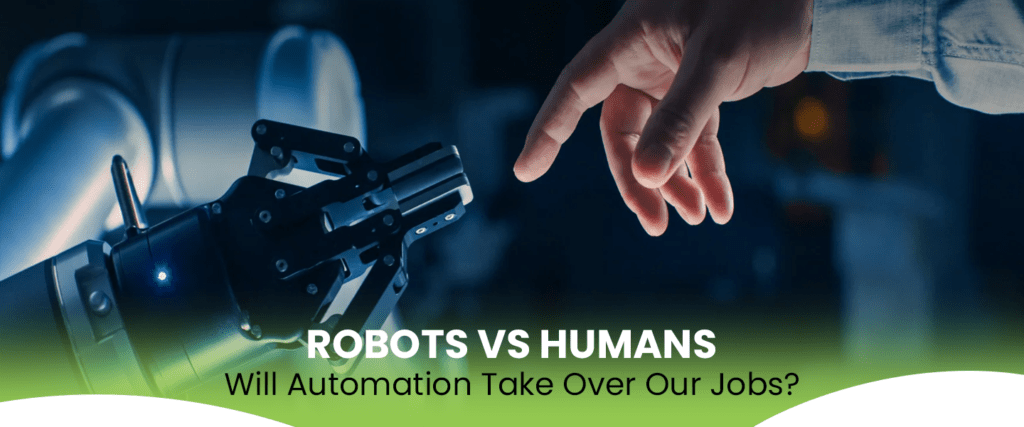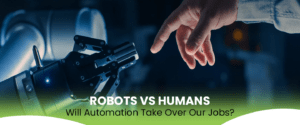At the present moment, the debate over automation’s role in the workforce continues to spark discussions and concerns around the world, particularly in sectors like textiles, where precision and efficiency are paramount. And that’s probably the reason why you were intrigued to open this blog in the first place.
Let’s be honest, the headlines can be scary. “Robots Taking Over Our Jobs!” screams one article. “Rise of the Machines!” shouts another. It’s enough to make anyone picture a scene straight out of a movie, with faceless robots coldly efficient at everything the humans do. But hold on a second, should we really be hitting the panic button already?
The truth, as with most things, is a little more nuanced. Automation, powered by AI and robotics, is definitely changing the way we work. But instead of a robot takeover, imagine a future where humans and machines work together as powerful allies.
Let’s dig into this complex issue and explore how striking a balance between human involvement and automation can lead to unparalleled efficiency and innovation.
Efficiency: Robots streamline workflows by performing tasks with consistent speed and accuracy, eliminating the variability inherent in human labor. This ensures a smooth and continuous production process, minimizing idle time and maximizing output. Additionally, robots can execute tasks in parallel, multitasking effectively to handle multiple operations simultaneously. As a result, processes become more streamlined and optimized, leading to increased overall efficiency and productivity.
Precision: Automated systems excel in performing tasks with a level of precision that surpasses human capabilities. They can execute intricate operations with consistent accuracy, ensuring uniformity and quality in the final output. This precision is particularly crucial in energy management, where small deviations can have significant impacts on performance and efficiency.
Scalability: One of the key advantages of automation is its scalability. Robots can be easily replicated or reconfigured to accommodate changes in production demands or operational requirements. Whether there’s a need to ramp up production during peak periods or scale back during off-peak times, automated systems offer the flexibility to adjust capacity accordingly. This scalability allows firms to optimize resource utilization and adapt to fluctuations in demand, without incurring excessive costs or logistical challenges associated with hiring and training additional human workers.
Cost Reduction: Automation in energy management translates to significant cost savings for organizations. By replacing manual labor with robots, companies can reduce labor costs, including wages, benefits, and training expenses. Moreover, automated systems operate with greater efficiency, minimizing waste and resource consumption. They also contribute to reducing the risk of costly errors or accidents, which can lead to downtime and associated losses. Overall, the implementation of automation results in a more cost-effective and sustainable approach to management, improving the bottom line for businesses while maintaining competitiveness in the market.
Safety: Robots play a crucial role in enhancing safety in handling hazardous or physically demanding tasks that pose risks to human workers. By delegating such tasks to automated systems, companies can protect their employees from exposure to dangerous environments, chemicals, or heavy machinery. Additionally, robots are equipped with sensors and safety features to detect and respond to potential hazards, mitigating the risk of accidents or injuries. This focus on safety not only safeguards the well-being of workers but also helps organizations comply with regulatory requirements and maintain a positive reputation within the industry.
Apart from the mainstream but important benefits, the scale of the advantages extends beyond them.
Data Analysis: Automated systems can analyze vast amounts of data in real-time, providing valuable insights into patterns, performance metrics, and potential areas for optimization.
Predictive Maintenance: Through continuous monitoring and analysis, robots can predict equipment failures or maintenance needs, enabling proactive interventions to prevent downtime and minimize disruptions.
24/7 Operations: Unlike human workers, robots can operate around the clock without the need for breaks or rest, ensuring uninterrupted production and service delivery.
Adaptability: With advancements in AI and machine learning, robots can adapt to changing conditions and optimize processes dynamically, improving responsiveness and resilience in the face of unforeseen challenges.
Integration with IoT: Automated systems can seamlessly integrate with Internet of Things (IoT) devices to create interconnected networks for efficient energy management, enabling remote monitoring, control, and optimization of energy systems.
In the ongoing debate between robots and humans in the industry, the solution doesn’t lie in choosing one over the other, but in harnessing the unique strengths of both. However, let’s be honest, the transition won’t be seamless. With the increasing automation, there will be a need for retraining and upskilling. Yet, this challenge doesn’t present a dead end but rather an opportunity.
The future workforce will require a new skill set, one that integrates technology with human expertise. This presents an opportunity to work smarter, not harder, freeing ourselves from mundane tasks to focus on what we humans excel at, innovation and creativity.


